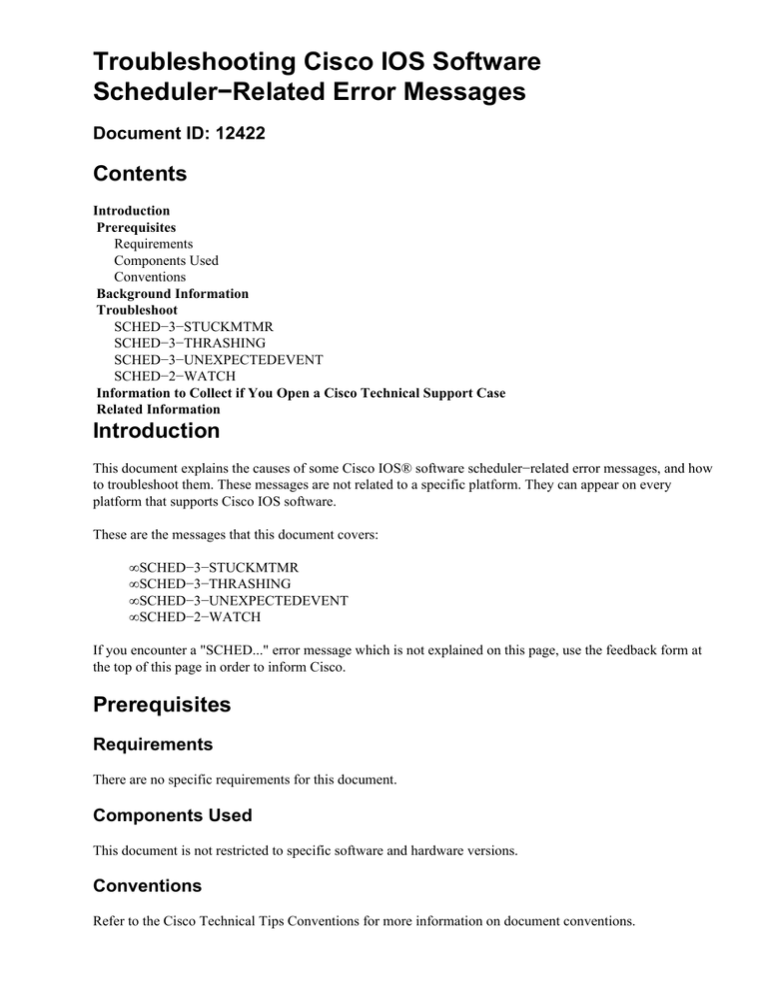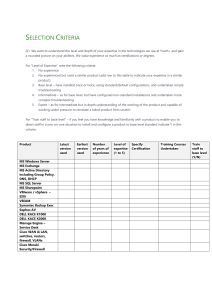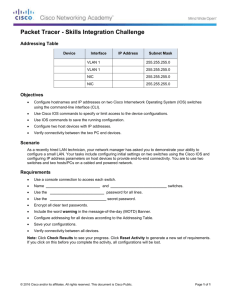
Troubleshooting Cisco IOS Software
Scheduler−Related Error Messages
Document ID: 12422
Contents
Introduction
Prerequisites
Requirements
Components Used
Conventions
Background Information
Troubleshoot
SCHED−3−STUCKMTMR
SCHED−3−THRASHING
SCHED−3−UNEXPECTEDEVENT
SCHED−2−WATCH
Information to Collect if You Open a Cisco Technical Support Case
Related Information
Introduction
This document explains the causes of some Cisco IOS® software scheduler−related error messages, and how
to troubleshoot them. These messages are not related to a specific platform. They can appear on every
platform that supports Cisco IOS software.
These are the messages that this document covers:
• SCHED−3−STUCKMTMR
• SCHED−3−THRASHING
• SCHED−3−UNEXPECTEDEVENT
• SCHED−2−WATCH
If you encounter a "SCHED..." error message which is not explained on this page, use the feedback form at
the top of this page in order to inform Cisco.
Prerequisites
Requirements
There are no specific requirements for this document.
Components Used
This document is not restricted to specific software and hardware versions.
Conventions
Refer to the Cisco Technical Tips Conventions for more information on document conventions.
Background Information
The Cisco IOS software scheduler, which is part of the Cisco IOS software Kernel, manages all the processes
in the system using a series of process queues that represent each process state. The queues hold context
information for processes in that state. Processes transition from one state to another as the scheduler moves
their context from one process queue to another. Some of the process queues are:
• Idle queueContains processes that are still active but wait on an event to occur before they run.
• Dead queueContains processes that have terminated, but need to have their resources reclaimed
before they can be totally removed from the system.
• Ready queuesContains processes that are eligible to run. There are four ready queues, one for each
process priority. When a running process suspends, the scheduler regains control of the CPU and uses
an algorithm to select the next process from one of its four ready queues.
Troubleshoot
SCHED−3−STUCKMTMR
A process can register to be notified when various events occur in the router. This specific message appears
whenever a registered timer expires and the timer value is unchanged after the process executes two
successive times. This is always a cosmetic software−related issue.
These messages on the console indicate such a problem:
%SCHED−3−STUCKMTMR: Sleep with expired managed timer 1C7410,
time 0x1063F9C52 (00:00:00 ago).
−Process= "IP SNMP", ipl= 6, pid= 44
−Traceback= 31BC79A 31BC9C0 323E130
The process in which this error message occurs is a good indication for narrowing down the cause of these
tracebacks. This list shows the more common reasons for these messages to appear:
• IP Simple Network Management Protocol (SNMP) ProcessThis message can appear during
SNMP WriteNet request:
%SCHED−3−STUCKMTMR: Sleep w/expired mgd timer 13AF58,
time 0xBDBE878A (00:00:03 ago).
−Process= "IP SNMP", ipl= 6, pid= 29
−Traceback= 313B218 313B5D2 3192A76 319EFEC 319F234 30FF17E 319F446 319F88E 30FEA70
3304C1E 33045F0 32F78E4 32F82AE 32F383E 32F7ABA 30FF19A
%SYS−4−SNMP_WRITENET: SNMP WriteNet request. Writing current configuration to
146.61.55.230.
%SYS−4−SNMP_WRITENET: SNMP WriteNet request. Writing current configuration to
146.61.10.20.
Earlier Cisco IOS software releases contained some IP SNMP poll−related problems. An upgrade to
the latest Cisco IOS Software Release 12.0 or 12.1 main release solves this issue. This is a cosmetic
message, and there are no adverse side−effects which might affect the operation of the router (or the
IP SNMP process).
• Virtual Integrated Network Service (VINES) Protocols ProcessThese tracebacks can be
generated on a router configured for VINES:
%SCHED−3−STUCKMTMR: Sleep w/expired mgd timer 6100606C, time 0x222DF318
(00:00:00 ago).
−Process= "VINES Protocols", ipl= 6, pid= 60
The message(s) occur(s) randomly and do(es) not appear to affect VINES performance. They occur if
VINES has missed processing an expired timed event (when the system processor is heavily loaded).
The event eventually gets processed, but not when it first expires.
VINES uses timers for processing and handling VINES Address Resolution Protocol (ARP) services,
Inter Processor Communication (IPC) sessions and retransmission, route aging, and some server
services.
These messages have been fixed in the Cisco IOS Software Release 12.0S and 12.1 main releases.
• Multi Protocol Label Switching (MPLS)−related ProcessThese tracebacks can be generated on a
router configured for MPLS:
%SCHED−3−STUCKMTMR: Sleep w/expired mgd timer 60C0E9B4, time 0x3952
(00:00:00 ago).
−Process= "TDP Hello", ipl= 5, pid= 58
−Traceback= 600867F0 60086BB8 604390D4 60077E88 60077E74
%SCHED−3−STUCKMTMR: Sleep w/expired mgd timer 60CC2548, time 0x43006
(00:00:00 ago).
−Process= "Tag Control", ipl= 5, pid= 56
−Traceback= 600867F0 60086BB8 60448320 604484F0 60077E88 60077E74
Analysis of the event loops for the Tag Distribution Protocol (TDP), TDP Hello, and Tag control
processes shows that the loops could call a specific process_wait_for_event process without
processing all expired timers. The loops are fixed to ensure that all expired timers are processed
before suspending. This issue is solved in the latest Cisco IOS Software Release 12.0S and 12.1 main
releases.
This list of processes where this message can occur is non−exhaustive. It is always a cosmetic message and,
therefore, does not justify a Cisco IOS software upgrade. Be sure to run the latest Cisco IOS software release
in your train. If the message still appears in the latest Cisco IOS software release which is available on
Cisco.com for registered users, contact Cisco Technical Support to open a case. At this time, provide a
complete show log with the error messages and a show tech of the router or switch on which the problem
occurs.
SCHED−3−THRASHING
This message means that the indicated process has relinquished control 50 consecutive times and there are still
outstanding events to be processed.
These messages on the console indicate such a problem:
%SCHED−3−THRASHING: Process thrashing on watched queue
'ARP queue' (count 54).
−Process= "ARP Input", ipl= 5, pid= 6
−Traceback= 6020589C 60205BC4 60236520 601F4FD8 601F4FC4
These thrashing checks are intended to determine if a process is, for some reason, does not do its job. The
thrashing check on watched queues (which is the troublesome message which is signaling) checks the number
of elements on the queue. If this number remains the same for a given number of schedulings, the message is
printed.
Some queues are length−limited. This means that if the router gets very busy, the queues always stay at the
maximum. As a result, the thrashing code in the scheduler gets confused and thinks that these queues have not
been handled. The thrashing code has determined that the process which was supposed to handle the queue
was not doing its job and prints the thrashing message.
The scheduler has been changed in later Cisco IOS software code. In order to keep track of whether the
queues have been changed (so it can better determine whether or not the process is thrashing), the scheduler
now notes whenever an item is removed from the queue, and only prints the thrashing message if nothing gets
removed for a while.
Most of the time, the queue thrashing message is cosmetic.
These messages are not always caused by a software bug. They can be issued in response to either
instantaneous or sustained demand on the router. Increased or persistent messages can indicate that the traffic
load needs to be reviewed.
Note: These code changes are reported under Cisco bug ID CSCdj68470 (registered customers only) .
SCHED−3−UNEXPECTEDEVENT
This message appears whenever a process receives an event that it does not know how to handle. For
example:
%SCHED−3−UNEXPECTEDEVENT: Process received unknown event (maj 10, min 0).
−Process= "IP SNMP", ipl= 0, pid= 23
−Traceback= 602842B8 6017CFB8 6017CFA4
There are several possible causes of this problem:
• The most likely cause is that one process directly wakes up another process, and passes major and
minor event numbers to the process. If the sending process wakes up the wrong process, the receiving
process does not know how to handle the received major and minor event numbers. The process
might perform the wrong action if it expects an event with matching major and minor event numbers,
or it might print this message. Use the output of the show process command to help determine which
process(es) might have sent a direct wakeup to a process.
• Another possible cause of this problem is that a development engineer has added code to register for
an event, but has not added the code to handle the event.
• A subroutine called by the process may have registered for a new event, but has not deregistered the
event before it exits.
These messages are always due to a software bug. Based on the process that did not know how to handle an
event, you can run into different bugs in the Cisco IOS software.
If the process is equal to either Exec or Virtual Exec, you are most likely to run into these issues:
%SCHED−3−UNEXPECTEDEVENT: Process received unknown event (maj 80, min 0).
−Process= "Exec", ipl= 0, pid= 20
−Traceback= 604A0D68 6049B400 6049C974 601B2F5C 601B338C 601CC384 601CC9E0 601F5628
602383EC 602383D8
or
%SCHED−3−UNEXPECTEDEVENT: Process received unknown event (maj 80, min 0).
−Process= "Virtual Exec", ipl= 0, pid= 2
−Traceback= 60479FA0 60474638 60476474 601B0E20 601B0A38 601E5088 601E5B08 601F0A54
60231324 60231310
This error message is caused by debug code that was accidentally left in some older versions of code. It has
reappeared in the Cisco IOS Software 12.0 mainline release. The error message is likely to occur if you have
TACACS configured and you execute the show line command on the command line interface (CLI) of the
router. The error message has no affect on the functionality of the router, so this can be considered as a
cosmetic bug. The only way to get rid of this error message is to upgrade the Cisco IOS software to a later
release.
You must run at least Cisco IOS Software Releases 12.0(11), 12.0(11)S, or 12.1(2), based on the train that you
run. However, if you are faced with another bug, consider an upgrade to the latest Cisco IOS software
available for the corresponding train. If the problem is still present in the latest Cisco IOS software release,
you can contact Cisco Technical Support to open a new bug. At this time, have ready the complete output of
the show logging command with the error messages and the output from the show version in order to decode
the tracebacks.
Refer to Cisco bug ID CSCdp17107 (registered customers only) for further information on this issue.
SCHED−2−WATCH
This message displays whenever an attempt is made to register for an event without first creating the data
structure for that event. This is an internal software bug in the Cisco IOS Software. The output looks
something like this:
%SCHED−2−WATCH: Attempt to enqueue uninitialized watched queue (address 0).
−Process= "Net Input", ipl= 0, pid= 29
−Traceback= 601B821C 60193428 604F59EC 604F6110 601C09F8 601934E0 6019304C
601A65E8 601A65D4
You can encounter this kind of error message during an Online Insertion and Removal (OIR) of any type of
card. For instance, on a Cisco 12000 Series Internet router, you can see these messages after you replace a
Gigabit Route Processor (GRP) card in a GSR12016 series router:
%SCHED−2−WATCH: Attempt to set uninitialized watched boolean (address 0).
−Process= "LC Crash Complete Process", ipl= 0, pid= 29
−Traceback= 60189CA8 60244E08 6017562C 60175618
Earlier versions of code contain some redundancy issues. Most of these problems are fixed in the latest Cisco
IOS Software Release 12.0S. Be sure to run a Cisco IOS software release which is later than or at least equal
to Cisco IOS Software Releases12.0(18)S1 and 12.0(17)S2. A cold reload of the router should most likely fix
this issue if a reseat of the faulty card does not work.
The messages are similar to this output on a 7500 Series Router:
%OIR−6−REMCARD: Card removed from slot 3, interfaces disabled
%SCHED−2−WATCH: Attempt to set uninitialized watched Boolean (address 0).
−Process= "OIR Handler", ipl= 0, pid= 7
−Traceback= 60236120 60C64838 60280594 60280874 602211BC 602211A8
Most of the time these SCHED error messages are due to an internal software bug in the Cisco IOS software.
Therefore, the first step in troubleshooting these error messages is to look for a known bug.
An upgrade to the latest Cisco IOS software image in your release train gets rid of all fixed Cisco IOS
software scheduler−related bugs.
If the problem still appears, contact your Cisco support representative with an exact copy of the error
message, along with the output from a show tech−support and a show log command.
Information to Collect if You Open a Cisco Technical
Support Case
If you still need assistance after you follow the
troubleshooting steps in this document, you can open a case
(registered customers only) with Cisco Technical Support.
Be sure to include the information listed here:
• Console captures that show the error messages.
• Console captures that show the steps you took to
troubleshoot the problem and the boot sequence during
each step.
• The hardware component that failed and the serial
number for the chassis.
• Troubleshooting logs.
• Output from the show technical−support command.
Attach the collected data to your case in non−zipped, plain text
format (.txt). You can upload information to your case with the
TAC Service Request Tool (registered customers only) . If you
cannot access the Case Query tool, you can send the information
in an E−mail attachment to attach@cisco.com. Include your case
number in the subject line of your message to attach the relevant
information to your case.
Note: Do not manually reload or power−cycle the router before
you collect this information, unless required. This can cause you
to lose important information that you need in order to
determine the root cause of the problem.
Related Information
• Technical Support & Documentation − Product Support Page
• Router Product Support
• Technical Support & Documentation − Cisco Systems
Contacts & Feedback | Help | Site Map
© 2014 − 2015 Cisco Systems, Inc. All rights reserved. Terms & Conditions | Privacy Statement | Cookie Policy | Trademarks of
Cisco Systems, Inc.
Updated: Jun 24, 2008
Document ID: 12422



